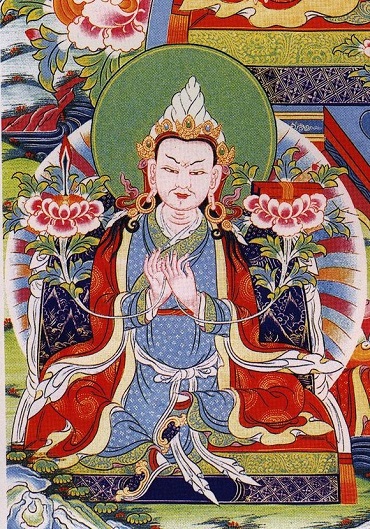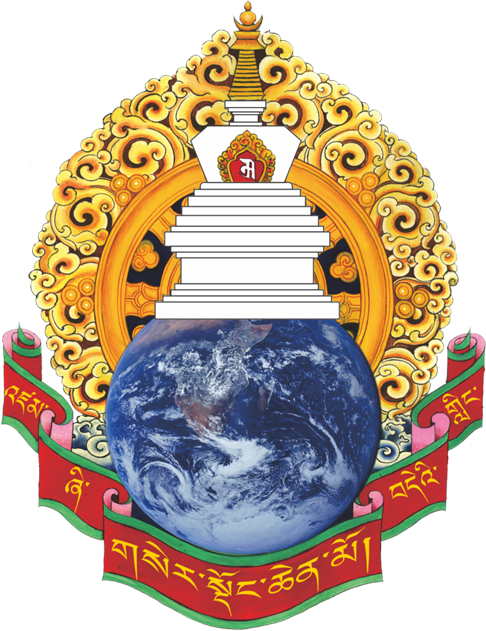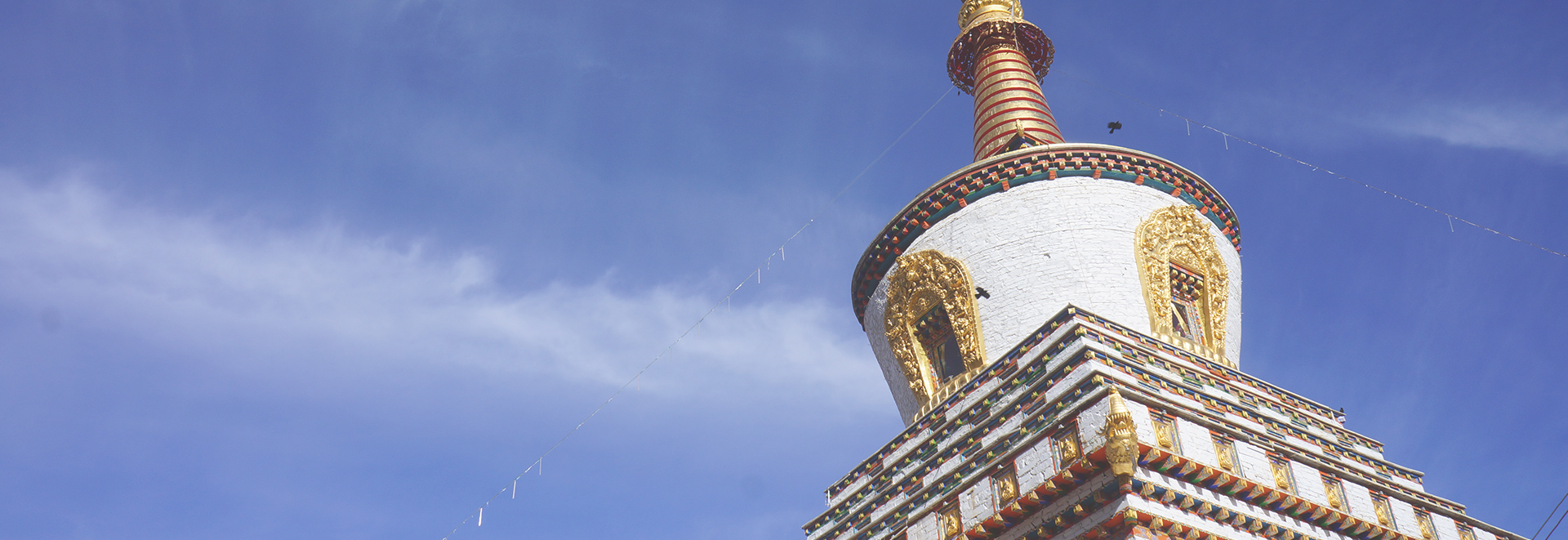Longchen Nyingtig Lineage
LINEAGE

King Trisong Detsen (790–858 CE) was the thirty-seventh ruler of Tibet in the Chögyal (Dharma King) dynasty, which originated with King Nyatri Tsenpo. Nyatri was believed to be a prince from India, who became the first king of Tibet in 127 BCE. King Trisong was the son of King Me Aktsomchen and Princess Chin Ch’eng Kun Chu, a daughter of King Li Lung Chi of China. At the age of thirteen he was enthroned as the thirty-seventh king of Tibet. He was a wise and powerful ruler who extended his kingdom far beyond the previous borders of Tibet.
He invited Shāntarakṣhita, the celebrated Mahāyāna scholar from India, to establish the Buddha Dharma in Tibet and to build Samye Monastery. But obstructions arose in the form of negative spirits and anti-Buddhist ministers in Tibet, and they were unable to carry out their plans. Shāntarakṣhita then made a prophecy, in accordance with which the king invited to Tibet Guru Padmasambhava, the greatest of the Indian Buddhist tāntrikas of that time. The guru came to Tibet, subdued all the human and nonhuman obstructions by his enlightened power, and bound all the spirits in Tibet to the service of the Dharma.
Since then Guru Padmasambhava has been known in Tibet by the name of Guru Rinpoche, the Precious Master. Thereafter the great Samye Monastery was completed in five years. One hundred and eight Indian scholars, including Guru Rinpoche, Shāntarakṣhita, and Vimalamitra, and Tibetan scholar-translators including Vairochana, Kawa Paltsek, Chok-ro Lü’i Gyaltsen, and Zhang Yeshe De, translated numerous scriptures of Hīnayāna, Mahāyāna, and Vajrayāna into Tibetan from Indian languages, mainly from Sanskrit. In many places institutions were built for study and training in the sūtric and tantric teachings.
At Samye Chimphu Guru Rinpoche conferred the empowerment of the great sādhanas of the eight maṇḍalas (sGrub Pa Ch’en Po bKa’ brGyad) of Mahāyoga to his chief disciples, the king and twenty-five subjects. By practicing the sādhanas of the various tutelary deities, they all achieved various siddhis. During the empowerment, the offering flower of the king landed upon the maṇḍala of Chechok Deshek Düpa, one of the eight maṇḍalas. The throwing of a flower on a group of maṇḍalas determines the tutelary deity through whom it will be appropriate for the disciple to practice. By practicing the sādhana of Chechok (Mahottaraheruka/Vajramahāheruka), the king achieved the attainment of unwavering contemplation.
His literary works include Ka Yangtakpe Tsema and Bumtik. He brought by force the relics of the Buddha from Magadha in central India and built many temples and stūpas to enshrine them.
The king died at the age of fifty-five (or fifty-nine). After his death he took rebirth as many great scholars, saints, and tertöns, in order to preserve and propagate the Dharma for future followers. Among his rebirths were Sangye Lama (1000–1080?), Nyang Nyima Özer (1124–1192), Guru Chöwang (1212–1270), Ogyen Lingpa (1329–1360/7), Pema Wangyal (1487–1542), Tashi Tobgyal (1550–1602), and the fifth Dalai Lama (1617–1682). Jigme Lingpa (1730–1798) and Khyentse Wangpo (1820–1892) were incarnations of both the king and Vimalamitra.
The king had three sons and two daughters. They all became great disciples of Guru Rinpoche and important figures in Dharma lineage. However, in the histories there are differences in the number, names, and seniority of the sons. Some scholars agree that he had three sons and that the eldest was Mu-ne Tsepo, the middle one was Murup(or Murum) Tsepo, and the youngest was Mutik (or Mutri) Tsepo.
When King Trisong Detsen was twenty-one, prince Mu-ne Tsepo was born to Queen Tsepongza. Mu-ne received teachings and empowerments from Guru Rinpoche and practiced them. At the age of forty-seven, he became the thirty-eighth ruler of Tibet, but he died after reigning for less than two years. In addition to the establishment of many Buddhist institutions, he is especially known for his attempts to distribute wealth equally among rich and poor, three times in his short reign. It is interesting to note that Rahula Sankritayana (1893– 1963), a great Indian scholar of Buddhism, even dedicated one of his books to Prince Mu-ne Tsepo, saying that he was the first socialist, a socialist king, in the world. Among Mu-ne Tsepo’s incarnations were Tülku Zangpo Trakpa (14th century), Drikung Rinchen Phüntsok (1509–1557), and Yonge Mingyur Dorje (1628–?).
When the king was twenty-two, Prince Murup (or Murum) Tsepo, alias Lha-se Tamdzin Yeshe Rölpatsal, was born to Queen Tsepongza. He received the teachings and empowerments from Guru Rinpoche and other teachers. He became a great scholar of the tantras, and by practicing the Vajrakīla sādhana he became a great adept. Also he was entrusted with the Lama Gongdü cycle of teachings by Guru Rinpoche. By accident he killed a son of a minister and was banished to the northern Tibetan border with China as military commander for nine years. Later he lived in Kongpo. Under his command the Tibetans defeated the forces of the Chinese and the Turks. At the end of his life, he dissolved into the light body. Among his incarnations were Sangye Lingpa (1340–1396), who discovered Lama Gongdü, Zhikpo Lingpa (1464–1523), Pema Norbu (1679– 1757), Dodrupchen Jigme Thrinle Özer (1745–1821), and Chogyur Dechen Lingpa (1829–1870).
Princess Nujin Sa-le was born to Queen Tsepongza. I could not find any account of her life.
Princess Pemasal was born to Queen Dromza Changchup. However, she died at the age of eight. Guru Rinpoche wrote a letter NṚI in red at the heart of her dead body, and by his enlightened power he recalled her consciousness to her body. When she had revived and was able to speak, Guru Rinpoche conferred on her the empowerment of Khandro Nyingthig and gave her the secret name of Pema Ledreltsal. He placed the casket containing the Khandro Nyingthig teachings on her head and spoke the following aspiration: “In future may you find this teaching, and may it be beneficial for many living beings.” Then he recorded these events and asked Khandro Yeshe Tsogyal to conceal the Khandro Nyingthig teachings for future followers. Then the texts were concealed in two different places. The elaborate teachings were hidden at the lionlike rock in lower Bumthang and the profound condensed teachings of the Nyingthig tantras for mendicants were hidden at Tanglung Tramo Trak in Takpo Valley. Then they were entrusted to the treasure-masterḍākinīs and the protectors Za and Mamo, who were instructed by Guru Rinpoche to hand the teachings over to the appropriate tertön in the future.
Among her incarnations were Pema Ledreltsal (1291–1319?), who discovered the Khandro Nyingthig teachings from Tanglung Tramo Trak; Longchen Rabjam (1308–1368), who propagated the teachings by writing and teaching; Pema Lingpa (1450–1521); and Lhatsün Namkha Jigme (1597–?).
When the king was fifty-nine, Prince Mutik (or Mutri) Tsepo, alias Senalek Jing-yön, was born to Queen Droza Changchup. He became the thirty-ninth king of Tibet. He received teachings and transmissions from Guru Rinpoche and achieved high attainments. He was the father of five sons: Tsangma, Gyalse Lhaje (aka Choktrup Gyalpo), Lhündrup, Tri Ralpachen, the fortieth ruler, and Lang Darma, the forty-first and last ruler of the Chögyal dynasty. As mentioned earlier, when Guru Rinpoche took leave of Tibet, Mutri was king.
Among his incarnations were Guru Jotse, Karma Chagme (1613– 1678), Zhechen Rabjam Tenpe Gyaltsen (1650–1704), and Apang Tertön (?–1945).
*Above Contents from Masters of Meditation and Miracles: Lives of the Great Buddhist Masters of India and Tibet by Tulku Thondup (1999).


